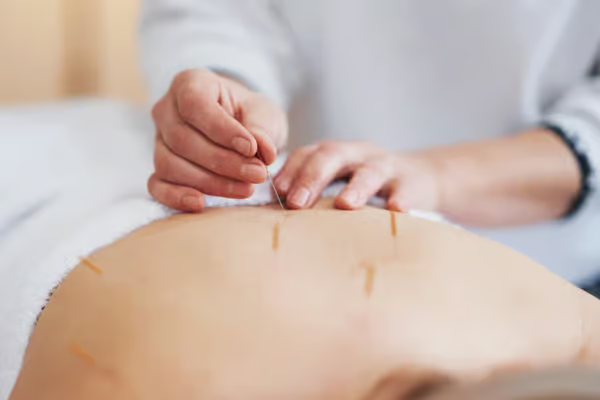Acupuncture is a natural alternative therapy for pain relief, gaining popularity for conditions like chronic pain, migraines, and arthritis. It involves inserting fine needles at specific body points, aiming to restore balance and stimulate the body’s healing processes. Acupuncture is rooted in traditional Chinese medicine, based on the concept of Qi, the vital energy flow in the body. By targeting acupoints, acupuncture helps alleviate pain by releasing endorphins, reducing inflammation, and improving circulation.
Poway, CA, United States, 25th Oct 2024 - Acupuncture has gained popularity as a natural therapy for pain relief, offering a gentle alternative to traditional medications. By inserting fine needles at specific points on the body, this ancient practice aims to restore balance and stimulate the body’s own healing processes. Many people have found it effective for conditions like chronic pain, migraines, and arthritis, often experiencing a sense of relaxation and well-being during and after sessions. As more individuals seek holistic approaches, acupuncture presents a compelling option for those looking to manage pain in a more natural way.
Understanding Acupuncture: The Basics
Acupuncture is a traditional Chinese medicine technique that dates back thousands of years, designed to promote healing and balance within the body. It involves the insertion of thin needles into specific points, known as acupoints, which correspond to different organs and systems. The theory behind acupuncture is rooted in the concept of Qi (pronounced "chee"), the vital energy that flows through the body. By stimulating these acupoints, acupuncture practitioners aim to restore the flow of Qi, alleviate pain, and enhance overall well-being. Understanding these fundamentals can help demystify the process and highlight its potential benefits for pain relief.
The Historical Roots of Acupuncture
Acupuncture's origins trace back over 2,500 years to ancient China, where it was first documented in texts like the Huangdi Neijing. This traditional practice was initially used to treat various ailments and promote overall health. The historical significance of acupuncture highlights its role as a foundational component of Chinese medicine, emphasizing the importance of balance and harmony within the body.
The Science Behind Acupoints
Acupoints are specific locations on the body that correspond to different organs and systems. Each point holds unique properties that influence physical and emotional health. The precise placement of needles in these areas can stimulate the body's natural healing processes, promoting circulation, reducing inflammation, and enhancing overall function. Understanding the science behind these acupoints can deepen appreciation for acupuncture’s therapeutic potential.
The Concept of Qi
Qi, often translated as "life force" or "vital energy," is central to acupuncture and traditional Chinese medicine. This concept represents the flow of energy within the body, influencing health and vitality. When Qi flows freely, the body maintains balance and wellness. However, blockages or imbalances in Qi can lead to pain and illness. Acupuncture aims to restore this flow, promoting healing and enhancing overall well-being.
How Acupuncture Alleviates Pain
Acupuncture alleviates pain by stimulating the nervous system and releasing endorphins, the body’s natural pain relievers. By targeting specific acupoints, this technique can reduce inflammation, improve blood flow, and enhance tissue healing. Patients often report immediate relief and improved long-term management of chronic pain conditions. This multifaceted approach makes acupuncture an effective alternative therapy for those seeking natural pain relief.
The Role of Practitioners
Skilled acupuncture practitioners play a vital role in the effectiveness of the treatment. They assess patients’ unique conditions and customize treatment plans based on individual needs. This personalized approach ensures that acupuncture addresses not only pain but also underlying issues contributing to health concerns. A practitioner’s expertise in locating acupoints and understanding each patient's specific needs is essential for achieving optimal results from acupuncture sessions.
How Acupuncture Alleviates Pain
Acupuncture alleviates pain through a multifaceted approach that engages both the nervous and endocrine systems. When needles are inserted into specific acupoints, they trigger a release of endorphins, the body's natural painkillers, providing immediate relief. Additionally, acupuncture promotes blood circulation to the affected areas, reducing inflammation and facilitating faster healing. Studies suggest that acupuncture can modulate pain perception in the brain, helping patients manage chronic pain conditions more effectively. This holistic approach not only addresses the symptoms of pain but also targets its underlying causes, offering a more comprehensive solution.
Common Conditions Treated with Acupuncture
Acupuncture is effective in treating a wide range of conditions, making it a versatile option for pain relief. Common ailments include chronic back pain, osteoarthritis, migraines, and neck pain. Additionally, many people seek acupuncture for stress-related issues, insomnia, and digestive disorders. Research shows that acupuncture can help reduce the frequency and intensity of migraines, ease the discomfort of arthritis, and alleviate muscle tension. By addressing both physical and emotional factors, acupuncture offers a holistic approach that resonates with individuals looking for natural therapies to manage their conditions.
What to Expect During an Acupuncture Session
During your first acupuncture session, the practitioner will conduct a thorough assessment, discussing your medical history and specific concerns. The session typically begins with you lying down comfortably, and the practitioner will insert very thin needles into designated acupoints. Many people report feeling minimal discomfort, often describing it as a mild tingling or warmth. The needles remain in place for about 20 to 30 minutes while you relax. Throughout the session, the practitioner may also incorporate other techniques, such as heat or electrical stimulation, to enhance the treatment's effectiveness, making each experience unique and tailored to your needs.
The Role of Personalized Treatment Plans
One of the strengths of acupuncture is its focus on individualized treatment plans. Every patient is different, and a skilled acupuncturist will tailor their approach based on your specific symptoms, lifestyle, and health goals. This personalized care ensures that the treatment addresses not only the immediate pain but also other contributing factors, such as stress or dietary habits. By continually assessing your progress and adjusting the treatment plan as needed, practitioners can maximize the effectiveness of acupuncture and improve your overall health. This bespoke approach fosters a deeper connection between the patient and practitioner, enhancing the healing journey.
Safety and Side Effects of Acupuncture
Acupuncture is generally considered safe when performed by a qualified practitioner using sterile, single-use needles. Most patients experience minimal side effects, which may include mild soreness or bruising at the needle insertion sites. Serious complications are rare but can occur, highlighting the importance of choosing a licensed acupuncturist. It’s also advisable to discuss any pre-existing conditions or medications with your practitioner to ensure a safe treatment experience. Overall, acupuncture is a low-risk therapy that provides an alternative option for those seeking relief from pain without the side effects commonly associated with pharmaceuticals.
Integrating Acupuncture with Other Therapies
Acupuncture can complement various other therapies, creating a more comprehensive approach to pain management. Many individuals find success when combining acupuncture with physical therapy, chiropractic care, or massage therapy. This integrative approach allows practitioners to address different aspects of pain and recovery, enhancing overall results. For instance, while acupuncture may help relieve muscle tension, physical therapy can improve mobility and strength. Communicating with your healthcare team about your treatment plans can ensure that all therapies work synergistically, providing a more holistic strategy for managing pain and promoting healing.
The Growing Acceptance of Acupuncture in Modern Medicine
As more individuals seek alternative therapies, acupuncture has gained recognition and acceptance in modern medicine. Many healthcare professionals now acknowledge its potential benefits for pain relief and overall wellness, often referring patients to acupuncturists. Research studies have provided evidence supporting its effectiveness for various conditions, leading to increased integration within conventional healthcare settings. Additionally, acupuncture is often covered by insurance plans, making it more accessible to a broader audience. This growing acceptance reflects a shift towards holistic health practices, as patients and providers alike recognize the value of combining traditional and alternative therapies.
Conclusion
Acupuncture presents a safe and effective natural alternative for pain relief, offering a holistic approach that addresses both physical and emotional well-being. With minimal side effects and a growing body of research supporting its benefits, many individuals are turning to this ancient practice as a complement to conventional treatments. At ActiveMed Integrative Health Center in Poway, CA, our experienced practitioners are dedicated to helping you achieve optimal health and wellness through personalized acupuncture therapies tailored to your specific needs.
If you’re interested in exploring acupuncture for pain relief, we invite you to contact us today. Reach out to ActiveMed Integrative Health Center at +1 (858) 673-4400 to schedule a consultation or learn more about our services. We look forward to helping you on your journey to better health!
ActiveMed Integrative Health Center
15725 Pomerado Rd STE 210, Poway, CA 92064
+18586734400
http://www.activemedhealth.com/
Media Contact
Organization: ActiveMed Integrative Health Center
Contact Person: ActiveMed Integrative Health Center
Website: https://activemedhealth.com/
Email: Send Email
Contact Number: +18586734499
Address:15725 Pomerado Rd STE 210, Poway, CA 92064
City: Poway
State: CA
Country:United States
Release id:19002
The post Acupuncture for Pain Relief A Natural Alternative Therapy appeared first on King Newswire. It is provided by a third-party content provider. King Newswire makes no warranties or representations in connection with it.
